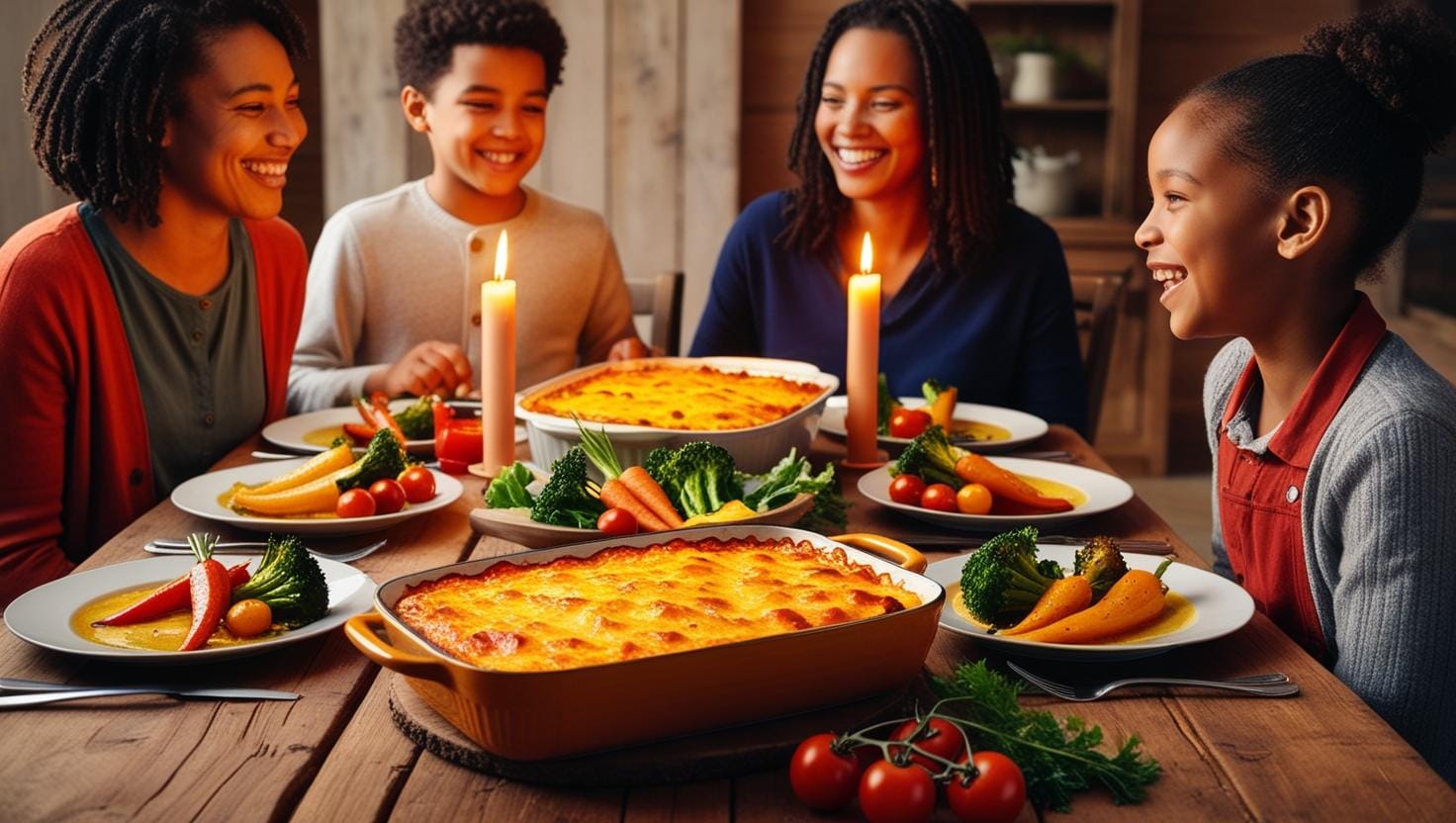Explore 10 easy, nutritious American dinners your family will love—perfect for busy weeknights and picky eaters.
Introduction: Healthy American Dinners: Meals for Stress-Free Nights
Dinner is more than just a meal. It is the heart of the home, a moment of connection, a chance to nourish both body and soul. For many American families, weeknight dinners are a cherished ritual, yet often a source of stress. Between hectic work schedules, picky eaters, and nutritional concerns, the dinner table can feel more like a battleground than a haven. But it doesn’t have to be this way.
This comprehensive guide presents ten wholesome, flavorful, and family-approved American dinner meal ideas designed to bring joy back to your evenings. Rooted in culinary tradition but mindful of modern health goals, these recipes are budget-friendly, easy to prepare, and packed with nourishing ingredients.
Why American Dinner Choices Matter Today
In today’s fast-paced society, the importance of a home-cooked dinner has never been greater. The rise in obesity, heart disease, and type 2 diabetes across the United States paints a worrying picture of the country’s dietary habits. Yet dinner presents a golden opportunity to reverse these trends, one plate at a time.
Public health experts agree that dinner is a pivotal meal, not just for daily nutrition but for setting long-term patterns. Research shows that families who dine together consume more fruits and vegetables, have lower obesity rates, and enjoy stronger emotional bonds.
Unfortunately, modern family life often pushes dinner down the priority list. Between school activities, long commutes, and screen time, the American dinner has been sidelined in favor of takeout and convenience foods. Reclaiming this meal can have transformative effects, creating positive ripple effects that extend far beyond the table.
What Are American Dinner Meal Ideas?
American cuisine is as diverse as the people who live here. It reflects a tapestry of cultural influences, from Native American corn-based dishes to Italian pastas, Mexican enchiladas, and East Asian stir-fries. American dinner meal ideas encompass this wide array of flavors and styles, offering something for every palate.
At its core, a typical American dinner consists of a protein (like chicken, beef, fish, or legumes), a starch (potatoes, rice, pasta), and vegetables. However, with the growing awareness of health and sustainability, more families are incorporating plant-based meals, whole grains, and globally inspired dishes into their routines.
The USDA recommends building meals that emphasize variety, balance, and moderation. A healthy dinner should include:
Lean protein
Whole grains
A variety of colorful vegetables
Healthy fats
Minimal added sugar and sodium
Let’s explore the types of common American dinners and how to make them healthier without compromising taste.
Types of Common American Dinners
Casseroles: Comfort food classics like chicken and rice bake, tuna noodle casserole, and lasagna. Easy to prep and great for leftovers.
Grilled Meats: Think barbecue chicken, steak with chimichurri, or honey-glazed salmon. Pair with veggies and whole grains for a balanced plate.
Fast Food Remakes: Homemade burgers, baked fries, and chicken nuggets using clean ingredients and healthier cooking methods.
Vegetarian Meals: Veggie stir-fries, lentil shepherd’s pie, and black bean tacos. Plant-forward, satisfying, and nutrient-rich.
Nutritional Insights on American Dinners
Portion sizes in the U.S. have ballooned over the past decades, contributing to the obesity epidemic. It’s essential to be mindful of serving sizes and nutrient density.
Saturated Fats: Limit butter, cream, and fatty cuts of meat. Use olive oil, avocado, or nuts instead.
Protein Balance: Include a mix of animal and plant proteins. Beans, tofu, lentils, eggs, fish, and poultry are great options.
Fiber Intake: Choose whole grains like brown rice, quinoa, and whole-wheat pasta to support digestion and heart health.
Busting the Myths Around American Dinners
Despite the stereotypes, American dinners are far more diverse and healthier than many people believe. Let’s debunk a few common myths:
Myth #1: All American Dinners Are Unhealthy
Not true. While some classic dishes are indulgent, many families prioritize fresh, wholesome ingredients. Grilled chicken with roasted veggies, quinoa bowls, and baked sweet potatoes are staples in many households.
Cooking methods matter too. Baking, grilling, and steaming preserve nutrients and reduce the need for excess fats. Using herbs and spices adds flavor without adding calories.
Myth #2: Americans Only Eat Fast Food
Yes, drive-thru meals are popular, but they don’t define American dining. Home cooking is alive and well, especially post-pandemic. From farm-to-table movements to food blogs and YouTube tutorials, there’s a growing passion for scratch cooking and regional culinary traditions.
Southerners enjoy collard greens and cornbread; Midwesterners love hearty casseroles; Californians favor avocado-topped everything; New Englanders treasure seafood chowders.
Myth #3: Healthy Meals Are Expensive
Whole foods don’t have to bust the budget. Beans, brown rice, frozen vegetables, and in-season produce are affordable and nutritious. Planning meals, shopping with a list, and cooking in bulk can dramatically reduce grocery bills while improving food quality.
The Johnson Family’s Dinner Makeover
The Johnsons, a family of four from Minnesota, were stuck in a rut of frozen pizza and takeout. With two working parents and two energetic kids, they lacked time and motivation to cook. After a health scare involving high blood pressure, they decided to make a change.
They started small: one home-cooked meal a week, then two, and gradually built momentum. They created a meal plan, prepped veggies on Sundays, and used a shared family calendar to assign cooking duties. Within weeks, they noticed big improvements.
Before & After: What Changed?
Shopping Habits: More fresh produce, fewer processed snacks
Weekly Planning: Reduced stress and mid-week meal panic
Portion Control: Switched to smaller plates and mindful eating
Energy Levels: Everyone felt more alert and less sluggish
Their favorite new dinners? Turkey meatballs with zoodles, chicken stir-fry, and homemade burrito bowls.
Quick Tips for Healthier American Dinners
5 Easy Tips to Eat Better at Night
Plan Ahead: Write a meal plan on Sunday. Knowing what’s for dinner eliminates decision fatigue.
Cook in Batches: Make double portions and freeze extras for busy nights.
Use Smart Swaps: Try Greek yogurt instead of sour cream, brown rice instead of white, or lettuce wraps instead of tortillas.
Add More Veggies: Aim to fill half your plate with vegetables.
Choose Cooking Methods Wisely: Grill, bake, roast, or steam instead of frying.
Printable Dinner Planning Checklist
Stay organized with our free downloadable dinner checklist. Includes:
Weekly meal planner
Grocery list template
Prep-ahead tips
Pantry inventory chart
Print it, pin it on the fridge, and simplify your dinner routine.
Expert Summary on American Dinner Choices
“Healthy dinners are not about deprivation; they’re about delicious, satisfying meals made with intention,” says Dr. Elena Hart, a registered dietitian at the Wellness Research Council. “When families prioritize home cooking, they gain more than nutrition—they gain time together, improved health outcomes, and lifelong habits.”
Her advice? Start simple. Focus on progress, not perfection. Even swapping out one takeout meal for a home-cooked dish each week can make a meaningful difference.
Take the Next Step: Start Planning Smarter Dinners
Are you ready to take control of your dinner routine? Download our free 7-Day Family Dinner Planner to get:
10 healthy recipe ideas
Kid-friendly options
Grocery lists by category
Budget-saving meal tips
Just enter your email to receive your guide and begin transforming your family dinners today.
FAQs About American Dinner Meal Ideas
Q1: What’s a balanced dinner meal look like?
A: A palm-sized portion of lean protein, a fist-sized portion of whole grains or starch, half a plate of vegetables, and a tablespoon of healthy fat like olive oil or nuts.
Q2: Can I prep meals ahead of time?
A: Yes. Chop vegetables, marinate proteins, and cook grains in advance to save time during the week.
Q3: What’s an example of a quick healthy dinner?
A: Baked salmon with quinoa and steamed green beans. It’s ready in under 30 minutes and full of nutrients.
Q4: How do I get my kids to eat healthier?
A: Make it fun. Use colorful veggies, involve them in cooking, and give creative names to dishes like “superhero soup” or “rainbow tacos.”
Q5: Are frozen veggies okay?
A: Absolutely. They’re often frozen at peak freshness and are just as nutritious as fresh ones, plus they save time.
Final Thoughts: Nourishing Families One Plate at a Time
Dinner is more than fuel. It is family, culture, health, and love served on a plate. With thoughtful planning and small steps, your evening meals can become a joyful, grounding ritual. Whether you’re trying to eat healthier, save money, or just bring everyone back to the table, these American dinner ideas offer a starting point.
Let each meal be a celebration of taste, togetherness, and well-being. And remember—the best dinner is the one shared with people you love.
Tags & Hashtags for Sharing
Tags: #AmericanDinners #HealthyFamilyMeals #DinnerIdeas #WeeknightRecipes #HomeCooking #MealPlanning #EasyHealthyMeals


